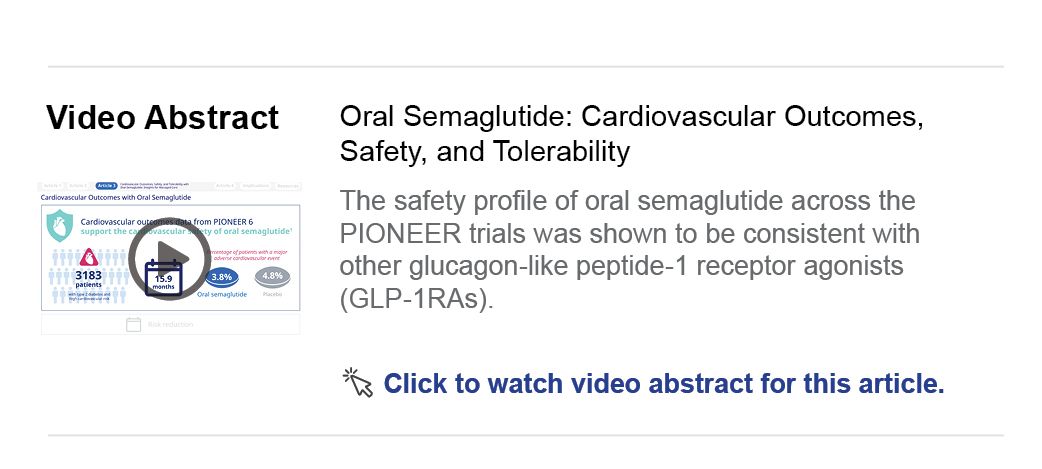- Center on Health Equity & Access
- Clinical
- Health Care Cost
- Health Care Delivery
- Insurance
- Policy
- Technology
- Value-Based Care
Cardiovascular Outcomes, Safety, and Tolerability With Oral Semaglutide: Insights for Managed Care
Abstract
It is important to consider the safety profile of new medications in type 2 diabetes (T2D) when selecting the most appropriate treatment option for each patient. This can help ensure that patients achieve optimal response, that those experiencing adverse events are appropriately managed, and that treatment is tailored for those with pre-existing conditions such as cardiovascular disease (CVD), which is the leading cause of death in patients with T2D. The American Diabetes Association and American Association of Clinical Endocrinologists/American College of Endocrinology recommend a glucagon-like peptide-1 receptor agonist (GLP-1RA) or sodium–glucose cotransporter 2 inhibitor with proven cardiovascular (CV) benefit in patients with established CVD or those at high risk of CVD. Injectable semaglutide is approved by the FDA for reducing the risk of major CV events in adults with T2D and established CVD. In PIONEER 6, the CV safety of the first GLP-1RA tablet, oral semaglutide, was noninferior to placebo, and a longer-term study (SOUL; NCT03914326) powered to assess a potential CV benefit is ongoing. The safety and tolerability profile of oral semaglutide across the PIONEER clinical trial program was consistent with the GLP-1RA class. The most common adverse events were gastrointestinal (GI) (eg, nausea, diarrhea, and vomiting), which were typically mild to moderate and transient. In clinical practice, oral semaglutide expands the treatment options available to patients with T2D and can be considered in patient populations suitable for injectable GLP-1RAs.
Am J Manag Care. 2020;26:S344-S355. https://doi.org/10.37765/ajmc.2020.88555
For author information and disclosures, see end of text.
Thinking Beyond Glycemic Control in Type 2 Diabetes
Selecting treatment for patients with type 2 diabetes (T2D) requires consideration of not only glycemic control, but also other factors such as comorbidities, body weight, hypoglycemia risk, drug safety profile, patient preferences, and costs.1,2 The latest standards of care from the American Diabetes Association (ADA), and the American Association of Clinical Endocrinologists/American College of Endocrinology (AACE/ACE), highlight in particular the important influence of comorbid cardiovascular disease (CVD), chronic kidney disease (CKD), and heart failure (HF) on treatment selection. Among a number of options widely available, glucagon-like peptide-1 receptor agonists (GLP-1RAs) are one possible treatment choice within these settings.1,2
Oral semaglutide became the first FDA-approved GLP-1RA in tablet form for the treatment of T2D in September 2019,3,4 and it is now approved in the European Union, United Kingdom, and Japan.5,6 Given that GLP-1RAs were previously only available as subcutaneous injections, the availability of an oral GLP-1RA formulation has the potential to expand the use of this class in patients who would benefit from the efficacy offered. This manuscript reviews the evidence for cardiovascular (CV) outcomes with oral semaglutide, explores the safety profile of oral semaglutide across the clinical trial program, and discusses its use in specific patient populations. Throughout, the profile of oral semaglutide is placed in context with that of injectable GLP-1RAs, and the implications for managed care are considered.
CV Risk and CV Outcomes Studies in T2D
Diabetes increases the risk of CVD in patients by approximately 2 to 3 times compared with patients without diabetes.7 CVD is estimated to account for over half of all deaths in patients with T2D8 and it leads to substantial economic costs,9 as described elsewhere in this supplement.10 In recent years, large-scale CV outcomes trials (CVOTs) have been conducted with many agents in T2D, in response to guidelines issued by the FDA and regulatory bodies.11 Based on these CVOTs, ADA Standards of Medical Care in Diabetes recommend preferential use of specific agents in settings related to CVD, regardless of glycated hemoglobin (A1C) level1:
- for patients who have established atherosclerotic CVD (ASCVD) or are at high risk of ASCVD, a GLP-1RA or a sodium–glucose cotransporter 2 inhibitor (SGLT2i) with proven CVD benefit is recommended (see Table 14,12-22 for GLP-1RAs with proven CVD benefit; the SGLT2is canagliflozin23 and empagliflozin24 have proven CVD benefit)
- for patients who have HF or CKD, an SGLT2i with evidence of reducing HF or CKD progression is recommended (empagliflozin, canagliflozin, or dapagliflozin), or a GLP-1RA with proven CVD benefit (Table 14,12-22) if an SGLT2i is contraindicated (eg, due to inadequate glomerular filtration rate) or not tolerated.
The AACE/ACE guidance is broadly consistent with these recommendations.2
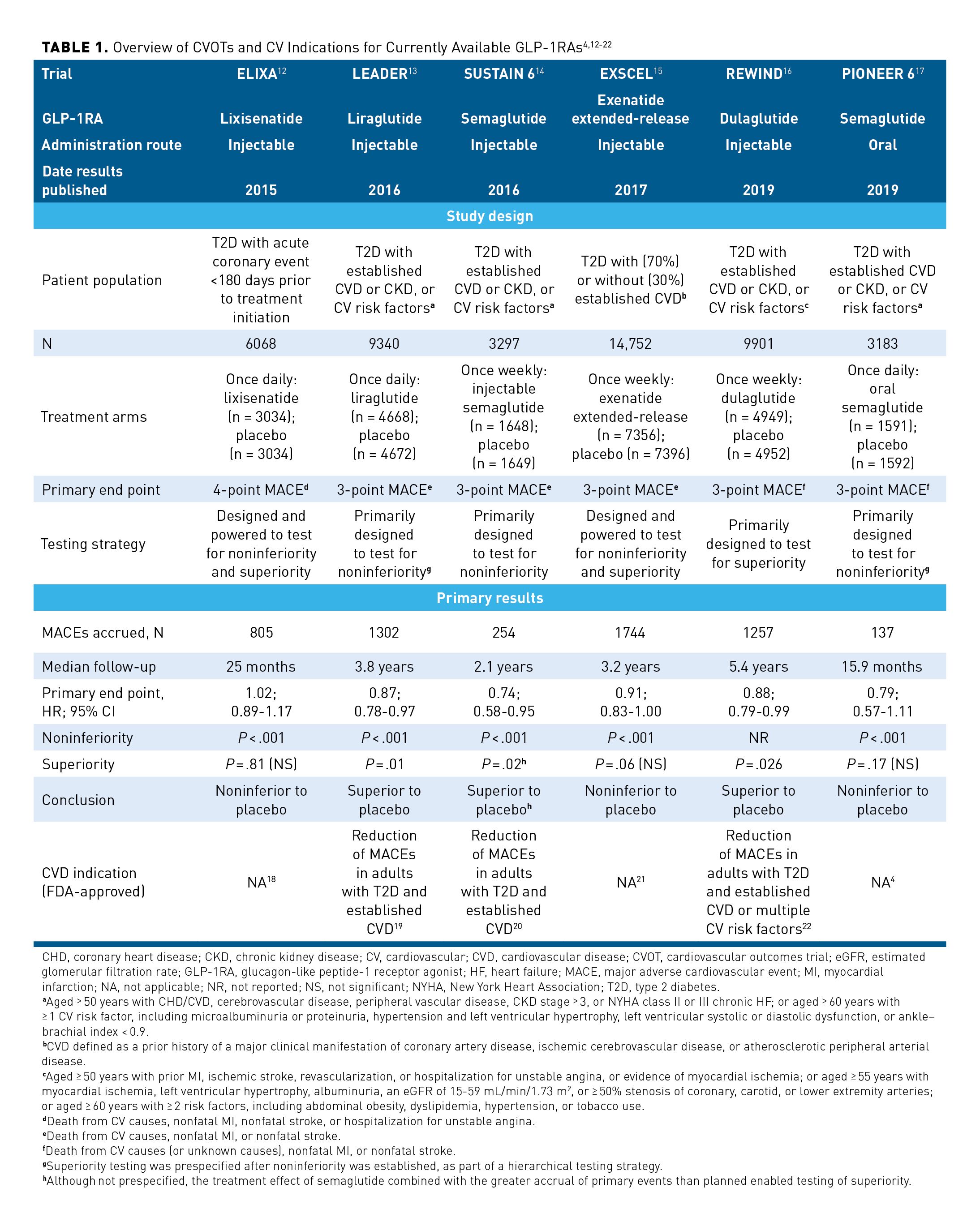
To date, 6 CVOTs have been conducted with the GLP-1RAs currently available in the United States11; an overview of these trials is provided in Table 14,12-22. The results of these CVOTs led to indications for dulaglutide, liraglutide, and injectable semaglutide for reducing the risk of major adverse CV events (MACEs) in patients with T2D with established CVD, or with multiple CV
risk factors (dulaglutide only).19,20,22
Cardiovascular Outcomes With Oral Semaglutide
PIONEER 6 Study Design
PIONEER 6 was designed to confirm that oral semaglutide does not increase CV risk compared with placebo.17 The study was conducted in patients with T2D at high risk of CV events, defined as: at least 50 years old with established CVD or CKD; or at least 60 years old with at least 1 CV risk factor (microalbuminuria, proteinuria, hypertension and left ventricular hypertrophy, left ventricular systolic or diastolic dysfunction, or an ankle–brachial index <0.9).17,25 Ultimately, 85% of enrolled patients had established CVD or CKD, and 15% had CV risk factors only.
In total, 3183 patients were randomized to once-daily oral semaglutide or placebo. Oral semaglutide was initiated at 3 mg and dose-escalated every 4 weeks to 7 mg and then to the target dose of 14 mg. The dose could be reduced from 14 mg if there were adverse events (AEs) and re-escalated once these resolved or diminished. Background standard-of-care therapy was continued, which at baseline included metformin for 77% of patients, insulin for 61%, sulfonylureas for 32%, SGLT2is for 10%, and antihypertensive, lipid-lowering, and antithrombotic/antiplatelet drugs for most patients.
Consistent with most prior CVOTs (Table 14,12-22), the primary outcome was the time to first occurrence of a composite 3-point MACE end point, consisting of death from CV causes (or unknown causes), nonfatal myocardial infarction, or nonfatal stroke. The trial was not designed to prove a CV benefit, but to confirm noninferiority of oral semaglutide versus placebo for the primary end point, and was event-driven, requiring 122 MACEs to be accrued to provide sufficient statistical power for noninferiority testing.
PIONEER 6 Results
Over a median follow-up of 15.9 months, the composite MACE end point was reported in 3.8% of patients in the oral semaglutide group versus 4.8% in the placebo group (HR, 0.79; 95% CI, 0.57-1.11), demonstrating noninferiority of oral semaglutide to placebo (P <.001), but not superiority (P = .17).17 When the individual MACE components were analyzed, a nominally significant reduction in the risk of death from CV causes was observed (HR, 0.49; 95% CI, 0.27-0.92), although the study was not sufficiently powered to establish superiority for this outcome. The confidence intervals for the other MACE components did not show any difference between treatments (Figure 1).17 The PIONEER 6 study investigators concluded that the CV risk profile of oral semaglutide was noninferior to placebo.
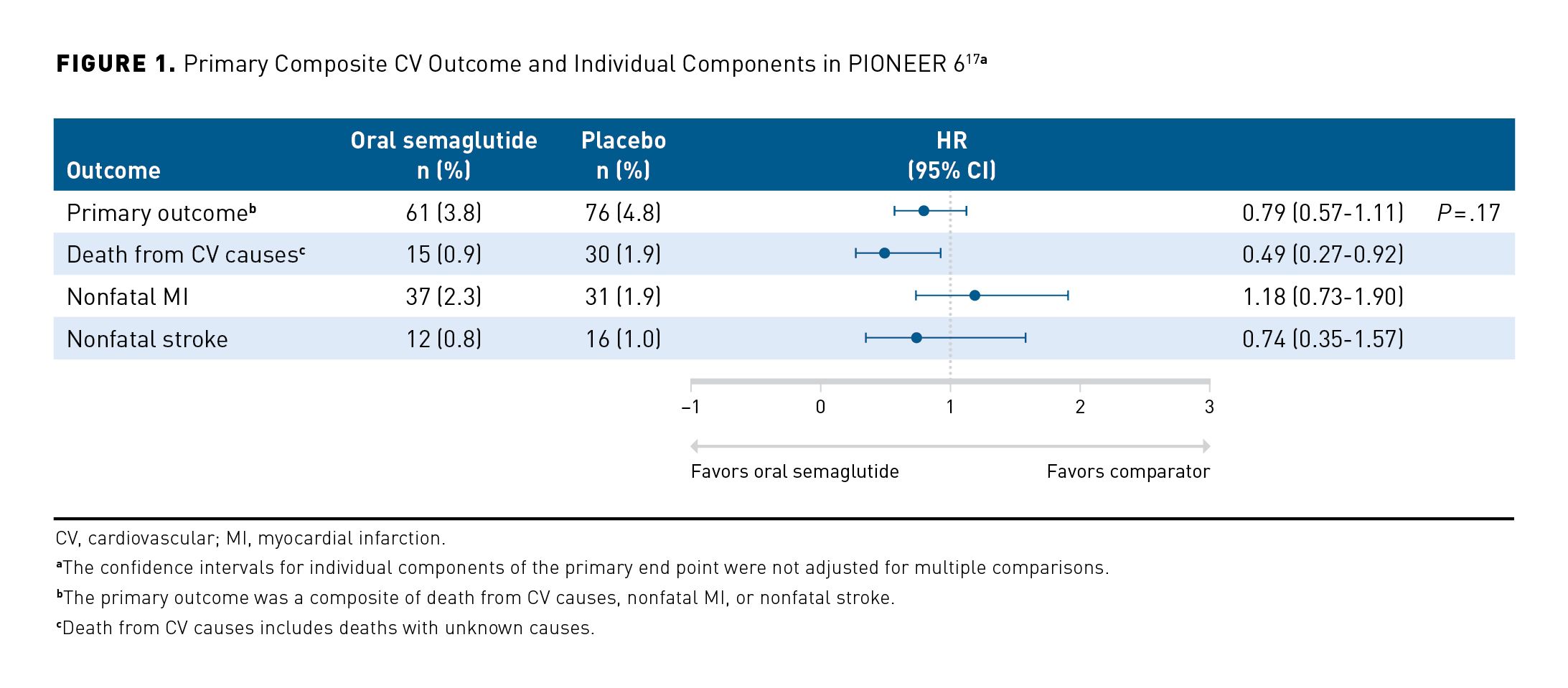
PIONEER 6 in Context
The lack of an increased CV risk seen in the PIONEER trials that assessed glycemic control is consistent with the evidence from PIONEER 6. In PIONEER 1 through 5, 7, and 8, discussed previously, an independent event adjudication committee (EAC) evaluated in-trial CV events in each study.26-32 In these 26- to 78-week studies, the proportion of patients that experienced EAC-confirmed CV events in the oral semaglutide groups was low (0%-3.2%) and similar to comparator groups (placebo, 1.1%-2.7%; empagliflozin 25 mg, 1.5%; sitagliptin 100 mg, 1.6%-2.1%; and liraglutide 1.8 mg, 1.1%).26-32
Certain CVOTs with injectable GLP-1RAs have reported significant reductions in MACEs, including liraglutide in LEADER, injectable semaglutide in SUSTAIN 6, and dulaglutide in REWIND.13,14,16 These GLP-1RAs are approved by the FDA for reducing the risk of MACEs in adults with T2D and established CVD.19,20,22 However, it is challenging to directly compare agents due to heterogeneity between the CVOT trials.12-17 In particular, CVOTs in T2D vary in terms of patient populations (from enrolling patients with established CVD only, to those with CV risk factors only, and different definitions of established CVD and CV risk factors) and numbers enrolled. They also differ in the duration of follow-up, the number of MACEs accrued prior to completion, and whether they were designed and powered to assess noninferiority or superiority versus placebo (Table 14,12-22).
The SUSTAIN 6 CVOT with injectable semaglutide enrolled a similar patient population to PIONEER 6, and used the same primary MACE end point, but was longer in duration and accrued more MACEs, enabling testing for superiority versus placebo.14,17 The HR for the primary MACE end point in SUSTAIN 6 for injectable semaglutide versus placebo (HR, 0.74; 95% CI, 0.58-0.95; P = .02) was broadly consistent with that in PIONEER 6.14,17 No significant differences were seen between injectable semaglutide and placebo for the individual MACE components in SUSTAIN 6, except for nonfatal stroke (HR, 0.61; 95% CI, 0.38-0.99); however, SUSTAIN 6 was also not designed to test superiority for these components.14 Insights from these 2 trials are complemented by a recent patient-level analysis, which combined data from PIONEER 6 and SUSTAIN 6. Consistent effects on MACE incidence across the 2 formulations were reported for combined semaglutide data (injectable and oral) versus placebo (overall HR, 0.76; 95% CI, 0.62-0.92).33
Summary
CV outcomes data from PIONEER 6 demonstrate no increased CV risk with oral semaglutide versus placebo.17 As such, oral semaglutide could be considered for use in patients with T2D at high CV risk, although the indication for oral semaglutide does not yet include an indication for CV risk reduction.4 Whether oral semaglutide reduces the risk of MACE is currently being investigated in a larger and longer (3.5-5 years) CVOT, SOUL, estimated to complete in 2024.34 In line with the latest standards of care, preferential consideration should be given to using an agent with a proven CVD benefit in those who have established ASCVD, or are at high risk of CVD, or who have CKD or HF.1,2
Oral Semaglutide Safety and Tolerability in Context
Overall Safety and Tolerability of Oral Semaglutide
The safety and tolerability of GLP-1RAs are well characterized from a large number of clinical trials35,36 and these agents have been used in clinical practice since 2005.37 The PIONEER clinical trial program assessed the safety and tolerability of oral semaglutide in a range of settings, including as an add-on to diet and exercise alone, oral therapies, and insulin-based regimens, as summarized in Table 217,26-32,38 and discussed below.

Incidence of GI AEs
Consistent with the known profile of GLP-1RAs, the most common AEs with oral semaglutide in clinical trials were GI, with nausea and diarrhea the most frequent manifestations (Table 2).17,26-32,38 These GI AEs were generally transient in nature, occurred during initiation and dose escalation,4 and were reported by fewer patients after this period; cases of nausea were typically mild to moderate in severity.17,26-32,39 These findings are consistent with those observed across the GLP-1RA class.35
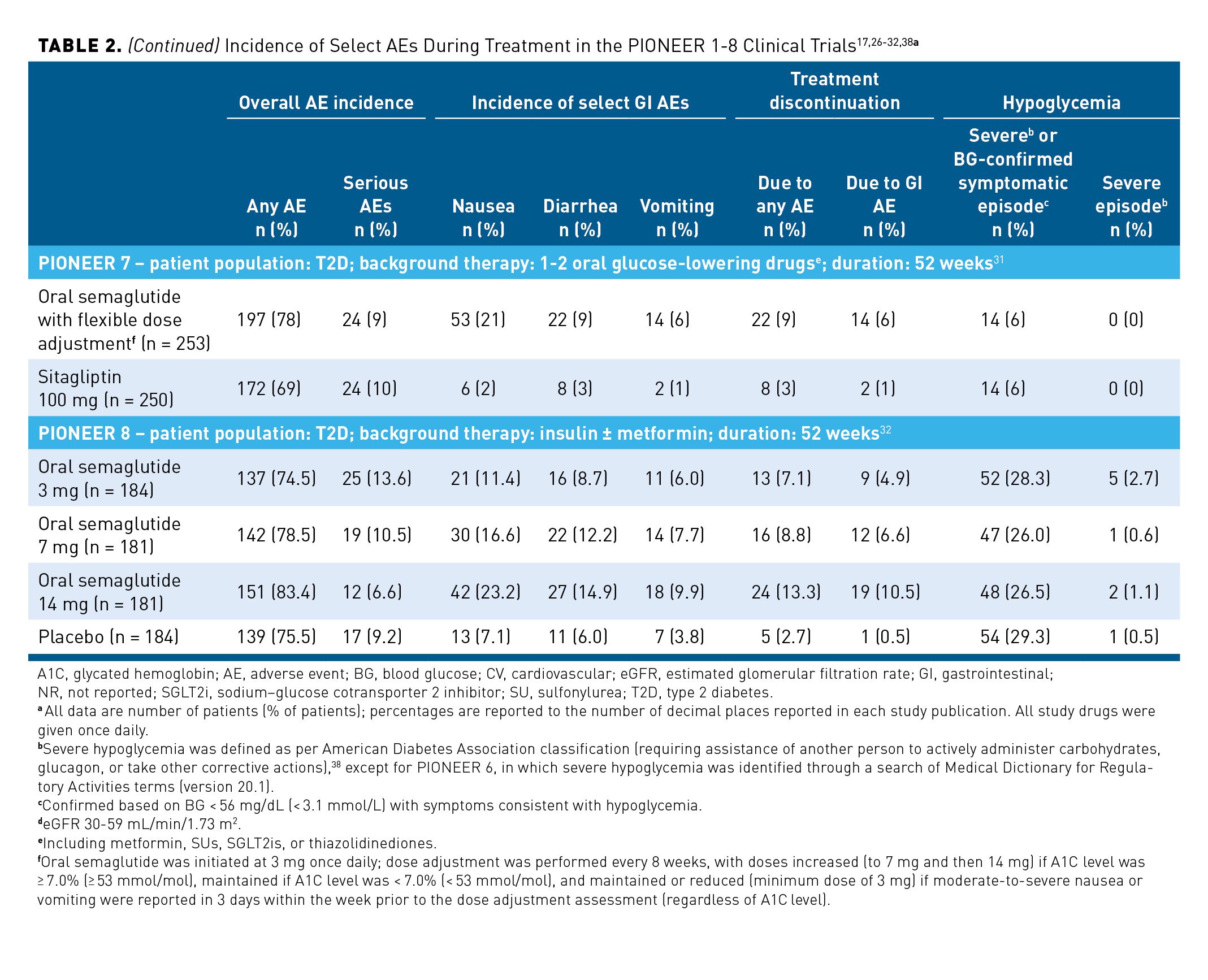
When compared with the injectable GLP-1RA liraglutide 1.8 mg, oral semaglutide 14 mg was associated with an overall comparable incidence of GI AEs (Table 217,26-32,38).29 To date, no studies have directly compared the GI tolerability of the approved doses of oral semaglutide with those for injectable semaglutide. However, the route of administration and GI tolerability were explored in an exposure–response analysis of data from the SUSTAIN and PIONEER programs, which indicated a consistent relationship between increased exposure and increased incidence of GI AEs for both oral and injectable formulations.40 Further insight from a recent systematic review and network meta-analysis of data from randomized controlled trials with GLP-1RAs indicated that the odds of experiencing GI AEs were not significantly different with oral semaglutide 14 mg versus injectable GLP-1RAs.41
As per recommendations for other GLP-1RAs,39 several strategies may help mitigate GI AEs. Firstly, gradual dose titration is important—oral semaglutide should be initiated at 3 mg once daily, then escalated to 7 mg after 30 days, and then to 14 mg after a minimum of a further 30 days (if needed for glycemic control).4 Based on clinical judgment, longer escalation periods can be considered in patients with a higher risk of GI AEs or those experiencing GI AEs at the lower doses (3 mg and 7 mg). In addition, patients should receive counseling on the potential for GI AEs, which are typically mild to moderate and transient in nature.17,26-32,39 Eating smaller meals, stopping eating before feeling full, and avoiding high-fat meals are recommended.39 Patients with renal impairment should also maintain fluid intake to avoid dehydration if GI AEs occur.4
Incidence of AEs Leading to Discontinuation
GI AEs were the most common cause of premature study drug discontinuations in the oral semaglutide trials (Table 217,26-32,38), occurring in 1.7% to 12% of patients across oral semaglutide groups versus placebo (0.5% to 2.0%).17,26-32 Observations from several PIONEER trials indicate that discontinuations due to AEs tend to occur within, or shortly after, the dose-escalation period. Compared with liraglutide 1.8 mg in PIONEER 4, oral semaglutide 14 mg was associated with a similar rate of discontinuations due to GI AEs (6.0% and 8.0% of patients, respectively) versus 2.0% of patients receiving placebo.29
Relative to other active comparators, discontinuations due to any AE in PIONEER 3 were similar between oral semaglutide 3 mg (5.6% of patients), 7 mg (5.8%), and sitagliptin 100 mg (5.2%), and comparable between oral semaglutide 14 mg (11.0%) and liraglutide 1.8 mg (9.0%) in PIONEER 4.28,29 Discontinuations were more common with oral semaglutide 14 mg (10.7%) compared with empagliflozin 25 mg (4.4%) in PIONEER 227; more frequent with oral semaglutide 14 mg (11.6%) versus sitagliptin 100 mg (5.2%) in PIONEER 328; and more common with flexible-dose oral semaglutide (up to 14 mg; 9%) versus sitagliptin 100 mg (3%) in PIONEER 7 (Table 217,26-32,38).31
Incidence of Serious AEs
Serious AEs were typically reported in similar proportions of patients in the oral semaglutide, placebo, and comparator groups across the PIONEER trials.17,26-32
Hypoglycemia
GLP-1RAs are considered to have neutral or low inherent risk of hypoglycemia,2,36 given their glucose-dependent mechanism of action.42 The PIONEER publications26-32 focus on 2 assessments of hypoglycemia incidence: episodes of severe hypoglycemia, defined using the ADA definition of “requiring assistance of another person to actively administer carbohydrates, glucagon, or take other corrective actions” 38; and blood glucose–confirmed symptomatic hypoglycemia (< 56 mg/dL [<3.1 mmol/L]) with symptoms consistent with hypoglycemia. In the PIONEER program, the combined incidence of severe hypoglycemia or blood glucose–confirmed symptomatic hypoglycemia with oral semaglutide was typically low, and similar to that observed with the GLP-1RA liraglutide, the SGLT2i empagliflozin, the dipeptidyl-peptidase-4 inhibitor (DPP-4i) sitagliptin, and placebo (Table 217,26-32,38).26-31 Severe hypoglycemic episodes were rare in the PIONEER studies (Table 217,26-32,38).
In PIONEER 3 and PIONEER 7, an elevated incidence of severe or blood glucose–confirmed symptomatic hypoglycemia was observed when oral semaglutide was added to a sulfonylurea (Figure 2).28,31,38 Similar observations were made with the combination of the DPP-4i sitagliptin and sulfonylureas.28,31 Consideration should therefore be given to reducing the dose of insulin secretagogues, such as sulfonylureas, when initiating treatment with any GLP-1RA, including oral semaglutide, to minimize the risk of hypoglycemia (Table 3).4,18-22,37
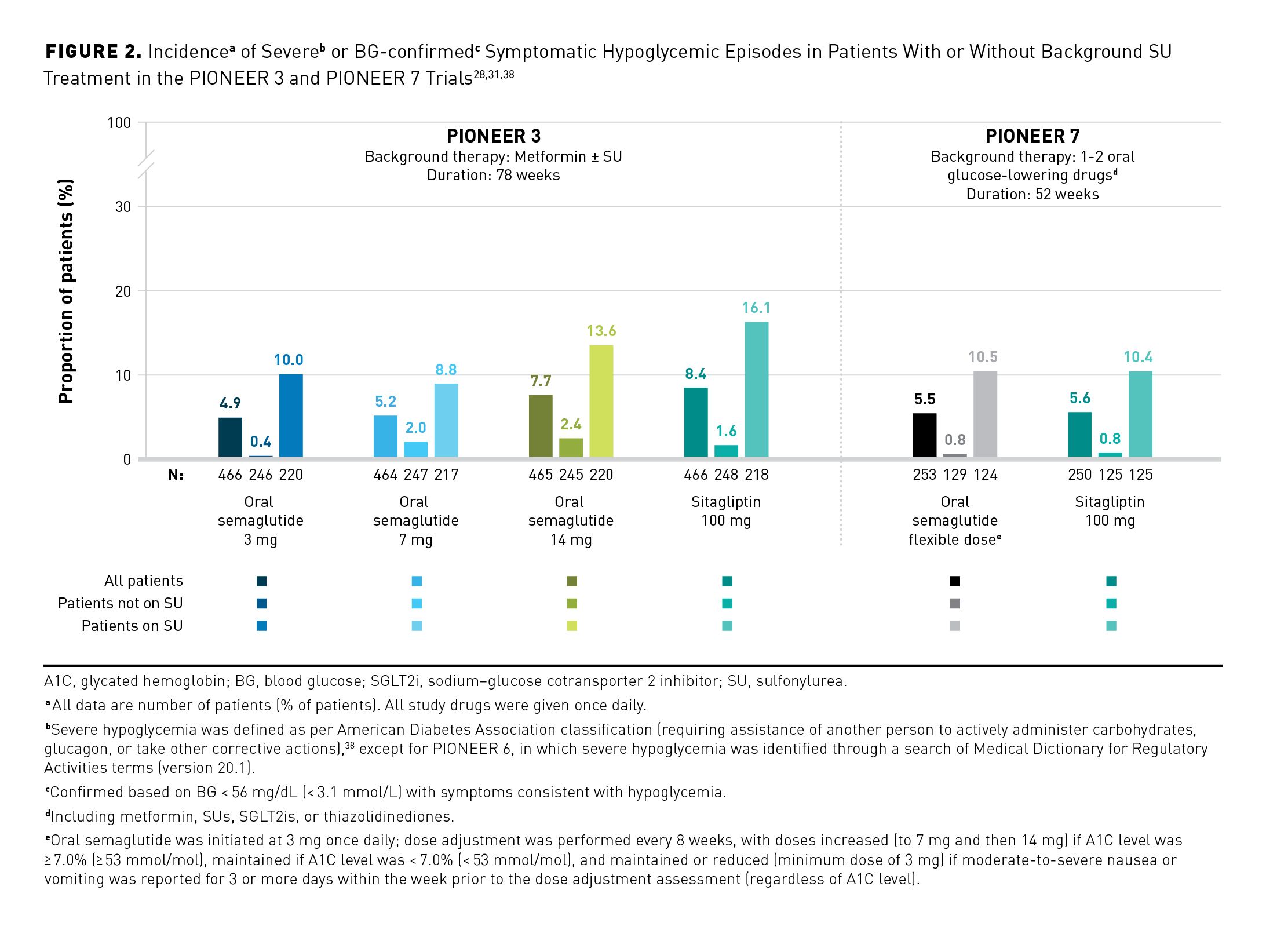
A similar approach is required in patients receiving background insulin therapy.4,18-22,37 When oral semaglutide was compared with placebo as an add-on to insulin in PIONEER 8, a 20% reduction in background insulin dose was recommended in both groups for the first 8 weeks, after which insulin doses could be adjusted up to the pre-randomization dose; after 26 weeks, doses could be freely adjusted at the investigator’s discretion.32 With this strategy, oral semaglutide did not increase the risk of severe or blood glucose–confirmed symptomatic hypoglycemia versus placebo over 52 weeks, despite the greater degree of glycemic control with oral semaglutide.32 However, the proportions of patients reporting such events in the oral semaglutide and placebo groups were greater than those in other PIONEER trials (Table 217,26-32,38),32 reflecting the inherent risk of hypoglycemia with insulin use.1,2,32 Most events occurred in patients receiving background basal-bolus insulin,32 highlighting the need for vigilance in those receiving insulin therapy with a prandial component.
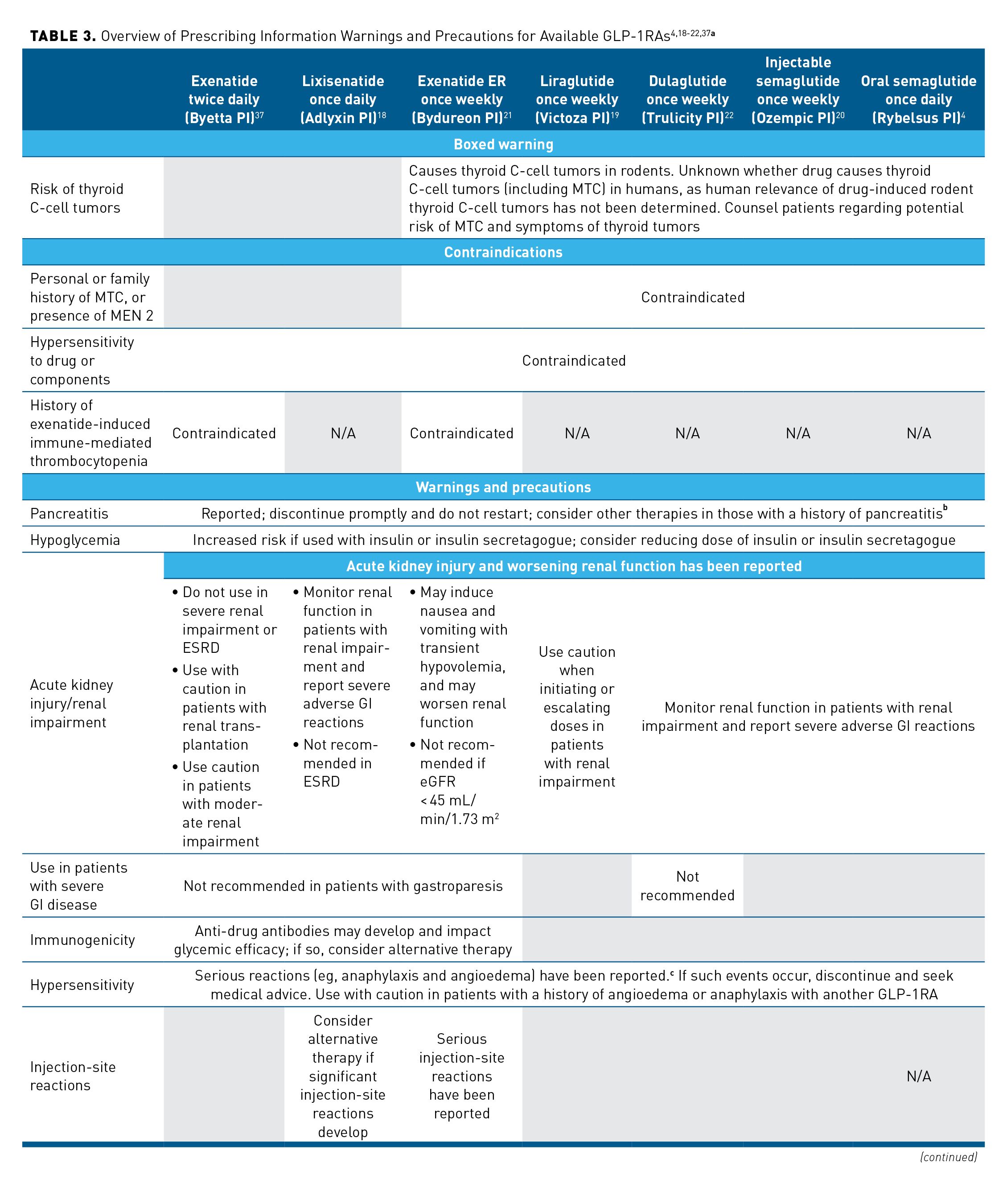
Warnings and Precautions for GLP-1RAs, Including Oral Semaglutide
Several precautions need to be considered when using GLP-1RAs, many of which are common across the class. These are summarized in Table 3,4,18-22,37 and select considerations are discussed in more detail below.
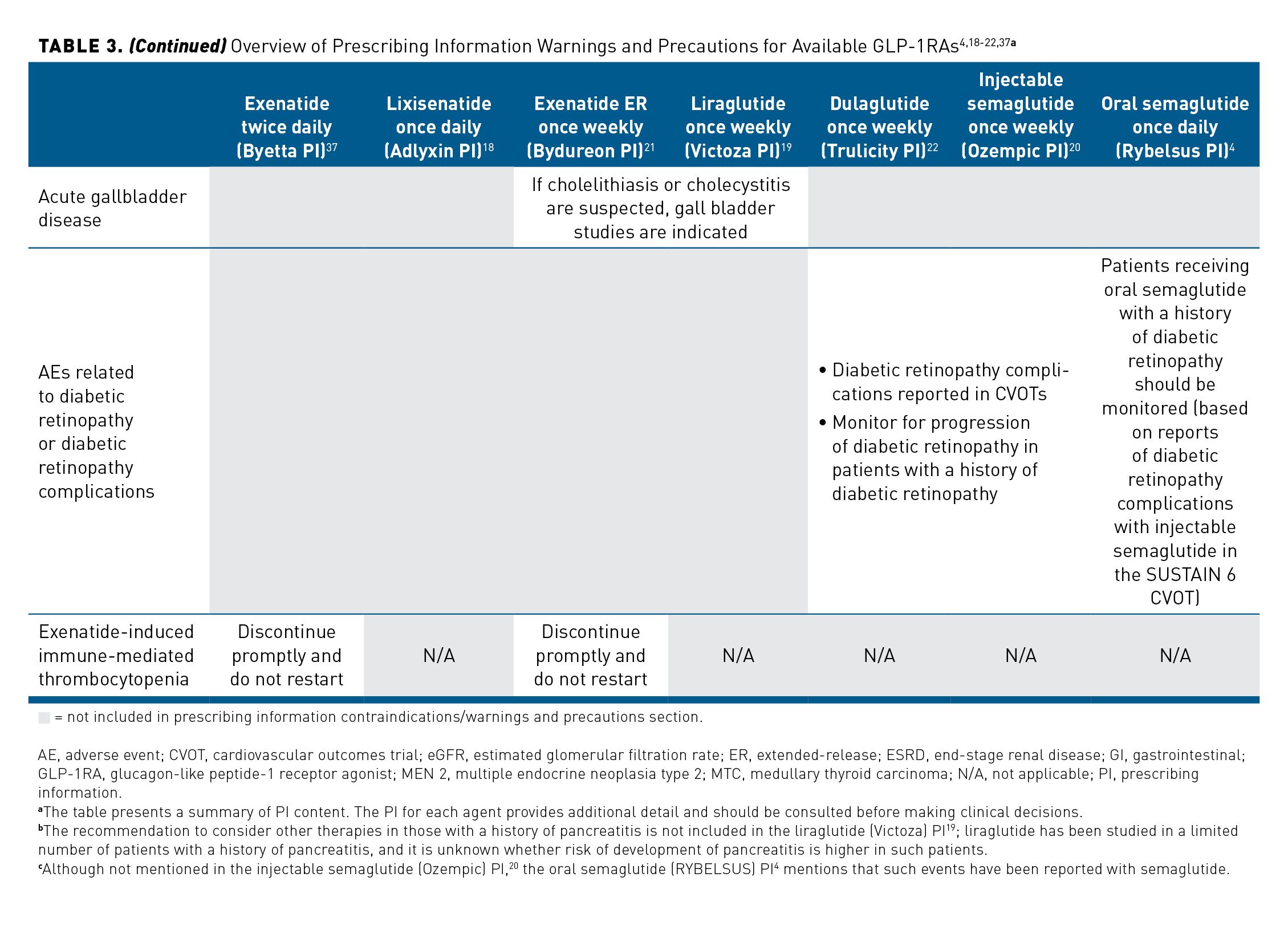
Risk of Thyroid C-cell Tumors
The GLP-1RAs exenatide extended-release, liraglutide, dulaglutide, and injectable and oral semaglutide have a boxed warning for thyroid C-cell tumors (observed in preclinical studies with rodents)4,19-22; however, the clinical relevance of this finding for humans is unknown. GLP-1RAs are contraindicated in patients with a personal or family history of medullary thyroid carcinoma (MTC), a rare cancer that originates from thyroid C-cells,43 and in patients with multiple endocrine neoplasia type 2. However, several meta-analyses of data from trials with injectable GLP-1RAs44,45 have not identified an increased risk of cancer, or a difference in overall risk between GLP-1RAs and comparators for thyroid cancers. Across the PIONEER 1 through 8 studies,17,25-32 a single case of MTC was reported with oral semaglutide; the patient had pre-existing thyroid nodules and an elevated baseline calcitonin level.17
Pancreatitis
Pancreatitis has been reported in patients taking incretin-based therapies, including GLP-1RAs.4,46 Analyses of the incidence of pancreatitis with such agents conducted by the FDA and European Medicines Agency (prior to the oral semaglutide phase 3 program) did not identify a causal relationship, concluding that current labeling recommendations are sufficient.46 The prescribing information for GLP-1RAs, including oral semaglutide, recommends halting therapy if pancreatitis is suspected; alternative agents should be considered in those with a history of pancreatitis.4,18-22,37 Recent meta-analyses of data from the GLP-1RA CVOTs (representing some of the largest and longest-duration studies with these agents), including PIONEER 6, have not identified an increased risk of pancreatitis.47,48
Diabetic Retinopathy
An increased incidence of diabetic retinopathy complications has been reported in patients treated with dulaglutide or injectable semaglutide versus placebo in CVOTs, driven by a greater rate in patients with a history of diabetic retinopathy,20,22 and which may be a phenomenon linked to rapid glucose lowering.14,49,50 Although an imbalance in AEs related to diabetic retinopathy was not observed with oral semaglutide compared with placebo (7.1% and 6.3%, respectively) in PIONEER 6, the study excluded patients with proliferative retinopathy or maculopathy.17 In patients with a history of diabetic retinopathy, monitoring for progression is recommended within the prescribing information for dulaglutide, injectable and oral semaglutide,4,20,22 and more generally should be considered for all patients with a history of diabetic retinopathy regardless of therapy, in line with ADA guidelines.51
Safety and Tolerability of Oral Semaglutide in Specific Patient Populations
Renal and Hepatic Impairment
The safety of oral semaglutide in patients with moderate renal impairment was explored in the PIONEER 5 study, with no unexpected safety concerns identified and a profile consistent with that of the GLP-1RA class (Table 217,26-32,38).30 Pharmacokinetic studies in patients with renal impairment (mild, moderate, severe, or end-stage renal disease) or hepatic impairment (mild, moderate, or severe) indicated that there were no clinically relevant differences in oral semaglutide plasma concentrations or safety in patients with such impairments compared with those with normal renal and hepatic function.52,53 Consequently, no dose adjustment is recommended in patients with renal or hepatic impairment.4 Additional renal considerations for oral semaglutide and other GLP-1RAs are shown in Table 3.4,18-22,37
Use in Elderly Patients
There are no overall differences in the safety of oral semaglutide between younger and older patients.4 Across the PIONEER 1 through 5, 7, and 8 trials, the proportions of patients discontinuing treatment due to AEs were, in general, slightly higher among those at least 65 years old compared with those less than 65 years old in both the oral semaglutide and comparator groups.54 For example, in PIONEER 2, discontinuations due to AEs with oral semaglutide 14 mg occurred in 15% versus 9% of patients aged at least 65 years and less than 65 years, respectively, and in 7% versus 3%, respectively, for empagliflozin 25 mg.54 Oral semaglutide is not indicated in patients less than 18 years old, as is the case for all GLP-1RAs, except for liraglutide which is approved for use in patients with T2D at least 10 years old.4,18-22,37
Use in Pregnancy
The effects of oral semaglutide in pregnancy are unknown; animal studies suggest a potential risk to the fetus, and consequently use during pregnancy is not recommended (unless the potential benefit justifies the risk), as is the case with all GLP-1RAs.4,18-22,37 Oral semaglutide should also be discontinued at least 2 months prior to planned pregnancy and it is not recommended while breastfeeding.4
In summary, the safety profile of oral semaglutide across the PIONEER trials was consistent with the known profile of GLP-1RAs,26,27,29-32 and oral semaglutide is subject to similar warnings and precautions to those with other GLP-1RAs.4,18-22,37 No dose adjustment is recommended in patients with hepatic or renal impairment.4
Acknowledgments
This article was supported by Novo Nordisk Inc; the company was provided with the opportunity to perform a medical accuracy review. Under the direction of the authors, medical writing and editorial support was provided by Nicole Cash of Axis, a division of Spirit Medical Communications Group Limited (funded by Novo Nordisk Inc).
Author affiliations: University of Texas Southwestern Medical Center (IL); WellDyne (PTA); Jefferson Health (TD).
Funding source: Financial support for this work was provided by Novo Nordisk Inc.
Author disclosures: Dr Lingvay reports institutional grant payments from GI Dynamics, Merck, Mylan, Novartis, Novo Nordisk Inc, and Pfizer; and personal fees from AstraZeneca, Boehringer Ingelheim, Duke CRI, Eli Lilly, Intarcia, Intercept, Janssen, Mannkind, Novo Nordisk Inc, Sanofi, TARGETPharma, Valeritas, and Zealand for consultancy. Dr Taddei-Allen reports that she is an advisory board member for Novo Nordisk Inc. Dr Dougherty has no relevant financial relationships with commercial interests to disclose.
Authorship information: Drafting the manuscript (IL, PTA, TD); critical revision of the manuscript for important intellectual content (IL, PTA, TD); responsibility for content (IL, PTA, TD).
Address correspondence to: Ildiko Lingvay, MD, MPH, MSCS, 5323 Harry Hines Blvd, Dallas, TX 75390. Email: Ildiko.Lingvay@utsouthwestern.edu. Phone: +1 214 645 8300.
References
1. American Diabetes Association. 9. Pharmacologic approaches to glycemic treatment: Standards of Medical Care in Diabetes-2020. Diabetes Care. 2020;43(suppl 1):S98-S110. doi:10.2337/dc20-S009
2. Garber AJ, Handelsman Y, Grunberger G, et al. Consensus statement by the American Association of Clinical Endocrinologists and American College of Endocrinology on the comprehensive type 2 diabetes management algorithm - 2020 Executive Summary. Endocr Pract. 2020;26(1):107-139. doi:10.4158/CS-2019-0472
3. FDA approves first oral GLP-1 treatment for type 2 diabetes. News release. US Food & Drug Administration. September 20, 2019. Accessed March 27, 2020. https://www.fda.gov/news-events/press-announcements/fda-approves-first-oral-glp-1-treatment-type-2-diabetes
4. Rybelsus. Prescribing information. Novo Nordisk Inc; 2020. Accessed April 16, 2020. https://www.accessdata.fda.gov/drugsatfda_docs/label/2020/213182s000,213051s001lbl.pdf
5. Rybelsus. Annex I: summary of product characteristics. Novo Nordisk Inc; 2020. Accessed June 11, 2002. https://www.ema.europa.eu/en/documents/product-information/rybelsus-epar-product-information_en.pdf
6. Rybelsus approved in Japan for the treatment of type 2 diabetes. Company announcement. Novo Nordisk Inc. June 29, 2020. Accessed July 22, 2020. https://ml-eu.globenewswire.com/Resource/Download/46a404a8-4e2b-41d5-a5fa-fa36cfae964f
7. Al-Salameh A, Chanson P, Bucher S, et al. Cardiovascular disease in type 2 diabetes: a review of sex-related differences in predisposition and prevention. Mayo Clin Proc. 2019;94(2):287-308. doi:10.1016/j.mayocp.2018.08.007
8. Einarson TR, Acs A, Ludwig C, Panton UH. Prevalence of cardiovascular disease in type 2 diabetes: a systematic literature review of scientific evidence from across the world in 2007-2017. Cardiovasc Diabetol. 2018;17(1):83. doi:10.1186/s12933-018-0728-6
9. American Diabetes Association. Economic costs of diabetes in the U.S. in 2017. Diabetes Care. 2018;41(5):917-928. doi:10.2337/dci18-0007
10. Dougherty T, Heile M. Type 2 diabetes in the US managed care setting: the burden of disease and rationale for an oral glucagon-like peptide-1 receptor agonist. Am J Manag Care. 2020;26(suppl 16):S325-S334. doi:10.37765/ajmc.2020.88552
11. American Diabetes Association. 10. Cardiovascular disease and risk management: Standards of Medical Care in Diabetes-2020. Diabetes Care. 2020;43(suppl 1):S111-S134. doi:10.2337/dc20-S010
12. Pfeffer MA, Claggett B, Diaz R, et al. Lixisenatide in patients with type 2 diabetes and acute coronary syndrome. N Engl J Med. 2015;373(23):2247-2257. doi:10.1056/NEJMoa1509225
13. Marso SP, Daniels GH, Brown-Frandsen K, et al. Liraglutide and cardiovascular outcomes in type 2 diabetes. N Engl J Med. 2016;375(4):311-322. doi:10.1056/NEJMoa1603827
14. Marso SP, Bain SC, Consoli A, et al. Semaglutide and cardiovascular outcomes in patients with type 2 diabetes. N Engl J Med. 2016;375(19):1834-1844. doi:10.1056/NEJMoa1509225
15. Holman RR, Bethel MA, Mentz RJ, et al. Effects of once-weekly exenatide on cardiovascular outcomes in type 2 diabetes. N Engl J Med. 2017;377(13):1228-1239. doi:10.1056/NEJMoa1612917
16. Gerstein HC, Colhoun HM, Dagenais GR, et al; REWIND Investigators. Dulaglutide and cardiovascular outcomes in type 2 diabetes (REWIND): a double-blind, randomised placebo-controlled trial. Lancet. 2019;394(10193):121-130. doi:10.1016/S0140-6736(19)31149-3
17. Husain M, Birkenfeld AL, Donsmark M, et al; PIONEER 6 Investigators. Oral semaglutide and cardiovascular outcomes in patients with type 2 diabetes. N Engl J Med. 2019;381(9):841-851. doi:10.1056/NEJMoa1901118
18. Adlyxin. Prescribing information. Sanofi-Aventis US LLC; 2019. Accessed March 28, 2020. http://products.sanofi.us/Adlyxin/Adlyxin.pdf
19. Victoza. Prescribing information. Novo Nordisk Inc; 2019. Accessed March 28, 2020. https://www.novo-pi.com/victoza.pdf
20. Ozempic. Prescribing information. Novo Nordisk Inc; 2020. Accessed April 17, 2020. https://www.accessdata.fda.gov/drugsatfda_docs/label/2020/209637s003lbl.pdf
21. Bydureon. Prescribing information. AstraZeneca Pharmaceuticals LP; 2020. Accessed April 17, 2020. https://www.accessdata.fda.gov/drugsatfda_docs/label/2020/022200s030lbl.pdf
22. Trulicity. Prescribing information. Eli Lilly & Co; 2020. Accessed April 17, 2020. https://www.accessdata.fda.gov/drugsatfda_docs/label/2020/125469s033lbl.pdf
23. Invokana. Prescribing information. Janssen Pharmaceuticals Inc; 2020. Accessed May 5, 2020. https://www.accessdata.fda.gov/drugsatfda_docs/label/2020/204042s036lbl.pdf
24. Jardiance. Prescribing information. Boehringer Ingelheim Pharmaceuticals Inc; 2020. Accessed May 5, 2020. https://www.accessdata.fda.gov/drugsatfda_docs/label/2020/204629s023lbl.pdf
25. Bain SC, Mosenzon O, Arechavaleta R, et al. Cardiovascular safety of oral semaglutide in patients with type 2 diabetes: rationale, design and patient baseline characteristics for the PIONEER 6 trial. Diabetes Obes Metab. 2019;21(3):499-508. doi:10.1111/dom.13553
26. Aroda VR, Rosenstock J, Terauchi Y, et al; PIONEER 1 Investigators. PIONEER 1: randomized clinical trial of the efficacy and safety of oral semaglutide monotherapy in comparison with placebo in patients with type 2 diabetes. Diabetes Care. 2019;42(9):1724-1732. doi:10.2337/dc19-0749
27. Rodbard HW, Rosenstock J, Canani LH, et al PIONEER 2 Investigators. Oral semaglutide versus empagliflozin in patients with type 2 diabetes uncontrolled on metformin: The PIONEER 2 trial. Diabetes Care. 2019;42(12):2272-2281. doi:10.2337/dc19-0883
28. Rosenstock J, Allison D, Birkenfeld AL, et al; PIONEER 3 Investigators. Effect of additional oral semaglutide vs sitagliptin on glycated hemoglobin in adults with type 2 diabetes uncontrolled with metformin alone or with sulfonylurea: the PIONEER 3 randomized clinical trial. JAMA. 2019;321(15):1466-1480. doi:10.1001/jama.2019.2942
29. Pratley R, Amod A, Hoff ST, et al; PIONEER 4 Investigators. Oral semaglutide versus subcutaneous liraglutide and placebo in type 2 diabetes (PIONEER 4): a randomised, double-blind, phase 3a trial. Lancet. 2019;394(10192):39-50. doi:10.1016/S0140-6736(19)31271-1
30. Mosenzon O, Blicher TM, Rosenlund S, et al; PIONEER 5 Investigators. Efficacy and safety of oral semaglutide in patients with type 2 diabetes and moderate renal impairment (PIONEER 5): a placebo-controlled, randomised, phase 3a trial. Lancet Diabetes Endocrinol. 2019;7(7):515-527. doi:10.1016/S2213-8587(19)30192-5
31. Pieber TR, Bode B, Mertens A, et al; PIONEER 7 Investigators. Efficacy and safety of oral semaglutide with flexible dose adjustment versus sitagliptin in type 2 diabetes (PIONEER 7): a multicentre, open-label, randomised, phase 3a trial. Lancet Diabetes Endocrinol. 2019;7(7):528-539. doi:10.1016/S2213-8587(19)30194-9
32. Zinman B, Aroda VR, Buse JB, et al; PIONEER 8 Investigators. Efficacy, safety, and tolerability of oral semaglutide versus placebo added to insulin with or without metformin in patients with type 2 diabetes: the PIONEER 8 trial. Diabetes Care. 2019;42(12):2262-2271. doi:10.2337/dc19-0898
33. Husain M, Bain SC, Jeppesen OK, et al. Semaglutide (SUSTAIN and PIONEER) reduces cardiovascular events in type 2 diabetes across varying cardiovascular risk. Diabetes Obes Metab. 2020;22(3):442-451. doi:10.1111/dom.13955
34. A heart disease study of semaglutide in patients with type 2 diabetes (SOUL). Clinicaltrials.gov. Updated August 24, 2020. Accessed September 2, 2020. https://clinicaltrials.gov/ct2/show/NCT03914326
35. Nauck MA, Meier JJ. Management of endocrine disease: are all GLP-1 agonists equal in the treatment of type 2 diabetes? Eur J Endocrinol. 2019;181(6):R211-R234. doi:10.1530/EJE-19-0566
36. Lyseng-Williamson KA. Glucagon-like peptide-1 receptor analogues in type 2 diabetes: their use and differential features. Clin Drug Investig. 2019;39(8):805-819. doi:10.1007/s40261-019-00826-0
37. Byetta. Prescribing information. AstraZeneca Pharmaceuticals LP; 2018. Accessed April 17, 2020. https://www.accessdata.fda.gov/drugsatfda_docs/label/2020/021773s043lbl.pdf
38. Seaquist ER, Anderson J, Childs B, et al. Hypoglycemia and diabetes: a report of a workgroup of the American Diabetes Association and the Endocrine Society. Diabetes Care. 2013;36(5):1384-1395. doi:10.2337/dc12-2480
39. Reid TS. Practical use of glucagon-like peptide-1 receptor agonist therapy in primary care. Clinical Diabetes. 2013;31(4):148-157. doi:10.2337/diaclin.31.4.148
40. Overgaard RV, Navarria A, Hertz CL, Ingwersen SH. Similar efficacy and gastrointestinal tolerability versus exposure for oral and subcutaneous semaglutide. Paper presented at: 55th Annual Meeting of the European Association for the Study of Diabetes; September 17–20, 2019; Barcelona, Spain. Accessed September 2, 2020. https://www.easd.org/virtualmeeting/home.html#!resources/similar-efficacy-and-gastrointestinal-tolerability-versus-exposure-for-oral-and-subcutaneous-semaglutide-b199246b-b3a1-42de-b18b-376635491ffd
41. Nuhoho S, Gupta J, Hansen BB, et al. Orally administered semaglutide versus GLP-1 RAs in patients with type 2 diabetes previously receiving 1-2 oral antidiabetics: systematic review and network meta-analysis. Diabetes Ther. 2019;10(6):2183-2199. doi:10.1007/s13300-019-00706-y
42. Aroda VR. A review of GLP-1 receptor agonists: evolution and advancement, through the lens of randomised controlled trials. Diabetes Obes Metab. 2018;20(suppl 1):22-33. doi:10.1111/dom.13162
43. Stamatakos M, Paraskeva P, Stefanaki C, et al. Medullary thyroid carcinoma: the third most common thyroid cancer reviewed. Oncol Lett. 2011;2(1):49-53. doi:10.3892/ol.2010.223
44. Cao C, Yang S, Zhou Z. GLP-1 receptor agonists and risk of cancer in type 2 diabetes: an updated meta-analysis of randomized controlled trials. Endocrine. 2019;66(2):157-165. doi:10.1007/s12020-019-02055-z
45. Guo X, Yang Q, Dong J, et al. Tumour risk with once-weekly glucagon-like peptide-1 receptor agonists in type 2 diabetes mellitus patients: a systematic review. Clin Drug Investig. 2016;36(6):433-441. doi:10.1007/s40261-016-0389-8
46. Egan AG, Blind E, Dunder K, et al. Pancreatic safety of incretin-based drugs—FDA and EMA assessment. N Engl J Med. 2014;370(9):794-797. doi:10.1056/NEJMp1314078
47. Kristensen SL, Rørth R, Jhund PS, et al. Cardiovascular, mortality, and kidney outcomes with GLP-1 receptor agonists in patients with type 2 diabetes: a systematic review and meta-analysis of cardiovascular outcome trials. Lancet Diabetes Endocrinol. 2019;7(10):776-785. doi:10.1016/S2213-8587(19)30249-9. Published correction appears in Lancet Diabetes Endocrinol. 2020;8(3):e2.
48. Marsico F, Paolillo S, Gargiulo P, et al. Effects of glucagon-like peptide-1 receptor agonists on major cardiovascular events in patients with type 2 diabetes mellitus with or without established cardiovascular disease: a meta-analysis of randomized controlled trials. Eur Heart J. Published online February 20, 2020. doi:10.1093/eurheartj/ehaa082
49. Bain SC, Klufas MA, Ho A, Matthews DR. Worsening of diabetic retinopathy with rapid improvement in systemic glucose control: a review. Diabetes Obes Metab. 2019;21(3):454-466. doi:10.1111/dom.13538
50. Vilsbøll T, Bain SC, Leiter LA, et al. Semaglutide, reduction in glycated haemoglobin and the risk of diabetic retinopathy. Diabetes Obes Metab. 2018;20(4):889-897. doi:10.1111/dom.13172
51. American Diabetes Association. 11. Microvascular complications and foot care: Standards of Medical Care in Diabetes-2020. Diabetes Care. 2020;43(suppl 1):S135-S151. doi:10.2337/dc20-S011
52. Granhall C, Søndergaard FL, Thomsen M, Anderson TW. Pharmacokinetics, safety and tolerability of oral semaglutide in subjects with renal impairment. Clin Pharmacokinet. 2018;57(12):1571-1580. doi:10.1007/s40262-018-0649-2
53. Baekdal TA, Thomsen M, Kupcová V, et al. Pharmacokinetics, safety, and tolerability of oral semaglutide in subjects with hepatic impairment. J Clin Pharmacol. 2018;58(10):1314-1323. doi:10.1002/jcph.1131
54. Aroda VR, Bauer R, Hertz CL, et al. Efficacy and safety of oral semaglutide by baseline age in the PIONEER clinical trial program. Paper presented virtually at: 80th American Diabetes Association Scientific Sessions; June 12–16, 2020. Accessed September 3, 2020. https://plan.core-apps.com/tristar_ada20/abstracts

